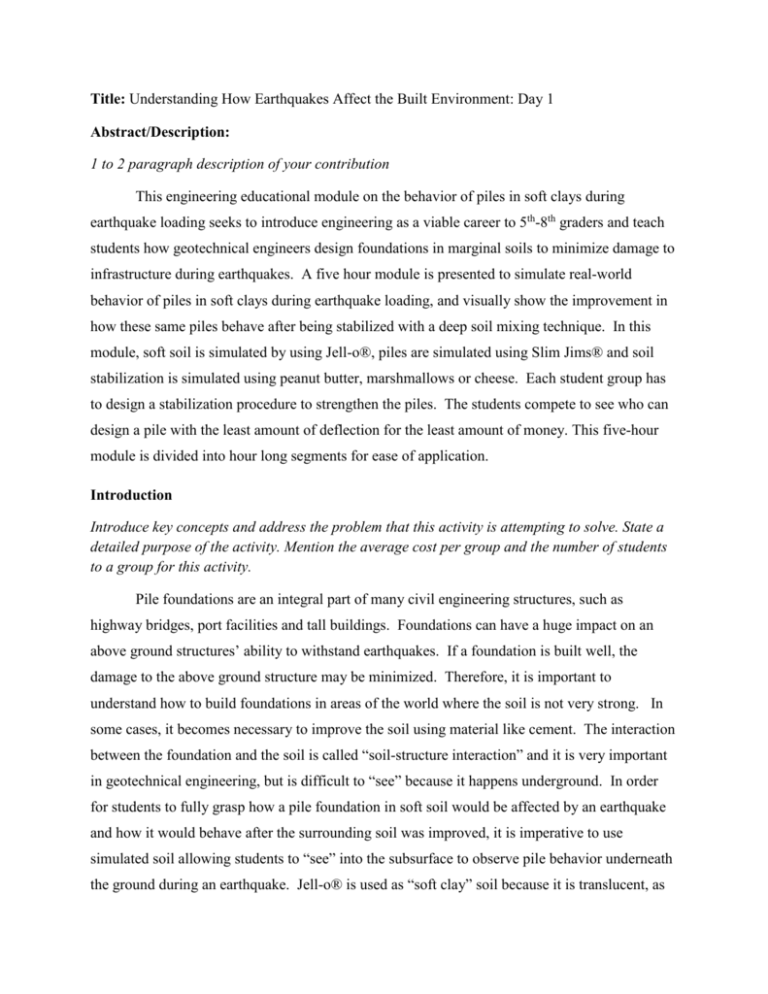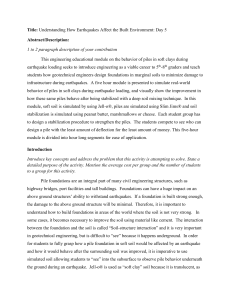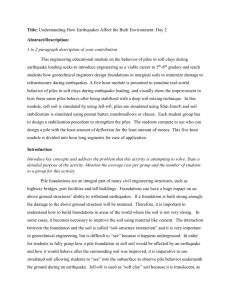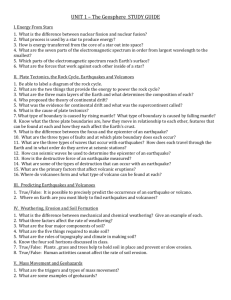structure interaction
advertisement

Title: Understanding How Earthquakes Affect the Built Environment: Day 1 Abstract/Description: 1 to 2 paragraph description of your contribution This engineering educational module on the behavior of piles in soft clays during earthquake loading seeks to introduce engineering as a viable career to 5th-8th graders and teach students how geotechnical engineers design foundations in marginal soils to minimize damage to infrastructure during earthquakes. A five hour module is presented to simulate real-world behavior of piles in soft clays during earthquake loading, and visually show the improvement in how these same piles behave after being stabilized with a deep soil mixing technique. In this module, soft soil is simulated by using Jell-o®, piles are simulated using Slim Jims® and soil stabilization is simulated using peanut butter, marshmallows or cheese. Each student group has to design a stabilization procedure to strengthen the piles. The students compete to see who can design a pile with the least amount of deflection for the least amount of money. This five-hour module is divided into hour long segments for ease of application. Introduction Introduce key concepts and address the problem that this activity is attempting to solve. State a detailed purpose of the activity. Mention the average cost per group and the number of students to a group for this activity. Pile foundations are an integral part of many civil engineering structures, such as highway bridges, port facilities and tall buildings. Foundations can have a huge impact on an above ground structures’ ability to withstand earthquakes. If a foundation is built well, the damage to the above ground structure may be minimized. Therefore, it is important to understand how to build foundations in areas of the world where the soil is not very strong. In some cases, it becomes necessary to improve the soil using material like cement. The interaction between the foundation and the soil is called “soil-structure interaction” and it is very important in geotechnical engineering, but is difficult to “see” because it happens underground. In order for students to fully grasp how a pile foundation in soft soil would be affected by an earthquake and how it would behave after the surrounding soil was improved, it is imperative to use simulated soil allowing students to “see” into the subsurface to observe pile behavior underneath the ground during an earthquake. Jell-o® is used as “soft clay” soil because it is translucent, as well as soft enough to show adequate deflections in an unimproved pile. Slim Jims® (beef jerky) are the pile material, creamy and crunchy peanut butter, small and large marshmallows, as well as sharp cheddar cheese are the stabilizing material to improve the pile performance, and Lollipops are inserted into the top of the Slim Jim® piles to simulate a structure. The students compete to see who can design a pile with the least amount of deflection for the least amount of money using a predetermined cost list and an optimization equation. This module can be administered to a class size as small as 5 to as large as 35 (or more) with enough help. The larger the class, the more Jell-o has to be made. The average 2011 cost per group, including all supplies and after a shaker has been built, is roughly $10, although this cost can be offset by having each student bring in a plastic tub, a box of Jell-o and some excavating spoons. Earthquake Engineering Component How does the goal of this activity relate to the mitigation of damage due to natural disasters such as liquefaction, tsunamis and earthquakes? How does your model relate to real life examples of what earthquake engineers and scientists do? Why is your model relevant to the field of earthquake engineering? The goal of this activity is to teach students about geotechnical engineering and strengthening foundations to lessen movements and therefore, damages, due to earthquakes. The model is a direct comparison to real-life examples of improving the behavior of bridges built in soft soil by using cement deep soil mixing to strengthen the existing pile foundations. In this case, the cement deep soil mixing is simulated using a variety of edible materials with different cohesive and strength properties, such as cheese, peanut butter and marshmallows. This model is relevant to the field of earthquake engineering because every year, thousands of people lose their lives due to structure collapses during and after earthquakes. Many of these collapses could be prevented by building better foundation systems. Objectives and Standards: A detailed itemized list of reading, writing, and scientific objectives and state the reading writing and subject national/state standard and the appropriate codes/grade levels. The specific learning outcomes of this module are to: 1. Learn the importance of geotechnical engineering and foundation systems in keeping structures safe during earthquakes. 2. Improve a zone of soft soil around piles to reduce movement, therefore, minimizing earthquake induced damage. 3. Gain insight into geotechnical engineering to broaden career path opportunities. 4. Improve the perceptions of engineers and the engineering profession. The standards pertaining to Day 1 of this module are as follows: OAC 210:15-3-78: Standards for Inquiry, Physical, Life, and Earth/Space Science Physical SCIENCE Process Standard 3.1. Ask questions about the world and design investigations that lead to scientific inquiry. Identify testable questions based on prior knowledge, background research, or observations. Process Standard 4.3. Evaluate data to develop reasonable explanation, and/or predictions. Process Standard 5.1. Ask questions that can be answered through scientific investigation. Process Standard 5.3. Use the engineering design process to address a problem or need (e.g., identify a need, conduct background research, prepare preliminary designs, build and test a prototype, test and revise design, communicate results). Material List A detailed itemized list of materials needed for Day 1 with specified quantities. Day 1 Module Teacher created powerpoint or slides discussing earthquakes and their damages to infrastructure Procedure: List the steps needed to complete the activity. Make sure your directions are clear. If there are any assessments during the activity, make sure to list them. If there are some steps/materials that can be optional, indicate this. This module is well-suited to be experienced in a continuous five-hour time span. However, since most Middle Schools operated on 50 minute class periods every day, we adapted this module to fit within the time constraints of most schools. Once the module begins, the timeline and content can follow the outline shown below. Please remember that this can be adapted to whatever timeframe is available, however, the “Jell-o® play” (Day 3) timeframe should not be shortened, because it is important for the students to experiment with varying stabilization materials and experience the performance of their piles. It is through this interactive experience that the students optimize their design and begin to understand the significance of soil-structure interaction while stabilizing foundations subject to earthquake loads. Day one of the classroom visits (Duration: 50 min-1 class period) 1- Introduction a. Question students about general earthquake knowledge - cause, mechanism, and effects. b. Show pictures of earthquake damage i. Ask for ideas of what causes damage ii. What factors contribute to the magnitude of damage? iii. Discuss soil-structure interaction and relate real life to model testing. e.g., soft clay is Jell-o®, etc. iv. See Jell-o Pre-Activity Worksheet Resources. Cite resources with appropriate links that were used for your activity. If your materials are something that should be ordered from a specific website, indicate this here. A full report on this module is given here: Cerato, A.B., Taghavi, A., Muraleetharan, K.K. and Miller, G.A. (2011). Understanding and Improving the Seismic Behavior of Pile Foundations in Soft Clays: An Educational Module. Report submitted to NEES-Comm, 80 pp. (https://nees.org/resources/2705) Assessment. If possible include examples(i.e.,) sentences of how these keywords are used. List any preembedded or post activity assessments here. Jell-o Activity Day 1: 1. Please circle those statements that you think describe the numbered phrase. ii. Geotechnical engineering o Examines how to design materials from geologic materials o Examines the engineering behavior of earth materials (soil and rock) o Determines the strength of soil and rock in various applications o All of the above o None of the above iii. Earthquakes are caused by o Release of energy from the earth’s crust o Shifts in tectonic plates o Volcanoes o All of the above o None of the above iv. Soil-structure interaction describes….. o How a structure is affected during external loading o How a foundation interacts with the superstructure o How a foundation is affected by the surrounding subsurface material during external loading o All of the above o None of the above 2. What do you think will happen to the pile when it is shaken during an earthquake in soft soil (Jell-o)? 3. What type of material do you think will work to strengthen foundations? 4. How large of an area will you have to strengthen to stop the movement of the pile? Extensions. How can this activity be connected to real life example? What additional assessments/procedures can be added to your activity? What additional test can be performed? How is this extension related to the original activity? If there are any additional materials used here, make sure to list them as optional in the material list section. This module is based on real life examples. Every structure built on this earth as some sort of foundation system, anchoring that structure to the ground. Buildings without adequate foundations in seismically active areas do not fare well. However all the public sees is the damage to the above ground structure, and thinks that if the above ground structure is made stronger it will fare better during earthquakes. While partially true, if the foundation system is not strong, no matter how strong the structure is built, it will always fail. The foundation system strength and flexibility is one of the major keys to building earthquake resistant structures, and introducing the concept of geotechnical engineering into middle schools can help to educate our future workforce. Scaling. If this activity can be scaled for a different grade level, indicate how it can be scaled and the appropriate grade level/standard codes. This module could also be used at various educational levels, from elementary to high school, as well as at the undergraduate level, with appropriate modifications. For example, in elementary school, the Jell-o play (Day 3) and Jell-o design (Day 4) could be the highlights of the module, whereas, in high school, the science behind soil stabilization could be stressed more, while still allowing the students to play with the Jell-o and stabilization procedures.







